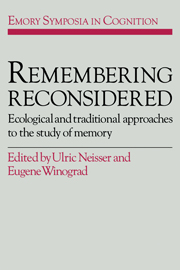Book contents
- Frontmatter
- Contents
- Preface
- List of contributors
- 1 New vistas in the study of memory
- 2 Continuities between ecological and laboratory approaches to memory
- 3 Memory for randomly sampled autobiographical events
- 4 Ordinary everyday memories: Some of the things of which selves are made
- 5 Walking in our own footsteps: Autobiographical memory and reconstruction
- 6 Memory observed and memory unobserved
- 7 The maintenance of marginal knowledge
- 8 The content and organization of autobiographical memories
- 9 The ontogeny of memory for real events
- 10 The functions of event memory: Some comments on Nelson and Barsalou
- 11 “The Wreck of the Old 97”: A real event remembered in song
- 12 Passive remembering
- 13 Remembering without experiencing: Memory for reported events
- 14 What is ordinary memory the memory of?
- 15 Go for the skill
- Name index
- Subject index
8 - The content and organization of autobiographical memories
Published online by Cambridge University Press: 25 March 2010
- Frontmatter
- Contents
- Preface
- List of contributors
- 1 New vistas in the study of memory
- 2 Continuities between ecological and laboratory approaches to memory
- 3 Memory for randomly sampled autobiographical events
- 4 Ordinary everyday memories: Some of the things of which selves are made
- 5 Walking in our own footsteps: Autobiographical memory and reconstruction
- 6 Memory observed and memory unobserved
- 7 The maintenance of marginal knowledge
- 8 The content and organization of autobiographical memories
- 9 The ontogeny of memory for real events
- 10 The functions of event memory: Some comments on Nelson and Barsalou
- 11 “The Wreck of the Old 97”: A real event remembered in song
- 12 Passive remembering
- 13 Remembering without experiencing: Memory for reported events
- 14 What is ordinary memory the memory of?
- 15 Go for the skill
- Name index
- Subject index
Summary
As evidenced by many of the chapters in this volume, as well as in Rubin (1987), cognitive psychologists have become increasingly interested in the study of autobiographical memories. But because this development is relatively recent, it understandably exhibits certain gaps and weaknesses. Although numerous experiments have addressed the retention of autobiographical memories, relatively few have addressed the content of autobiographical memories, how they are organized, or how they are related to world knowledge. Although a fair amount of empirical work has addressed autobiographical memories, no major theories have been proposed to account for them or to integrate them with other phenomena such as comprehension, learning, and problem solving.
A benefit of the cognitive science atmosphere that has grown with the development of cognitive psychology is that diverse methodological and theoretical frameworks contribute to one another's development. Insights from one approach fill gaps, stimulate new research, and occasionally restructure another approach. This chapter reflects such cross-fertilization. My initial interest in autobiographical memories was stimulated by Janet Kolodner's computational theory of autobiographical memories (Kolodner, 1978, 1980, 1983a,b, 1984; Schank & Kolodner, 1979), and our discussions of this work led to some very preliminary attempts to integrate psychological and computational perspectives (Kolodner & Barsalou, 1982, 1983).
In contrast to cognitive psychology, computational work on autobiographical memories has primarily been theoretical and has focused on the content and organization of autobiographical memories, along with their relation to world knowledge.
- Type
- Chapter
- Information
- Remembering ReconsideredEcological and Traditional Approaches to the Study of Memory, pp. 193 - 243Publisher: Cambridge University PressPrint publication year: 1988
- 205
- Cited by

